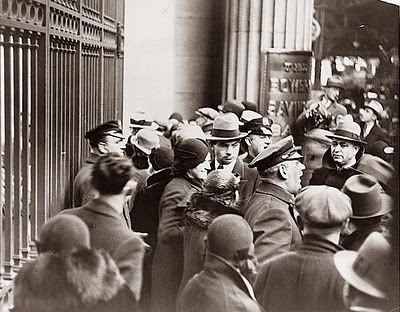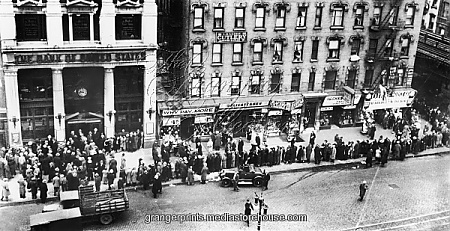Bank Run in New York City 1930
Video of a bank run (It’s a Wonderful Life) http://www.youtube.com/watch?v=EOzMdEwYmDU.
Depositor, “I want my money now!” Banker replies, “We lent it to your neighbor.” Again, how can two different entities have ownership of the same property at the same time? Whoops?!
T-Accounts to Understand FRB
A brief primer on Fractional Reserve Banking (“FRB”) with T-accounts showing how banks create money out of “thin air.” The article and the second one provide a good background to understand how FRB creates instability with or without the Fed or a Gold Standard in the third link below. http://mises.org/daily/4499/
I encourage everyone to read through the T-accounts. If you don’t understand how banking works—avoid investing—or read further in the best book ever written to understand banking principles: http://mises.org/Books/mysteryofbanking.pdf
Another discussion: Is our money based on debt? http://mises.org/daily/4631
How FRB curses us with Instability
http://www.mises.org/daily/6100/Fractional-Reserves-and-Economic-Instability
During a period known as the Great Moderation, roughly 1983–2000, the US economy experienced a period of apparent relative stability and prosperity. The US economy was then buffeted by two boom-bust cycles tied directly to credit expansion and low interest rates driven by fractional-reserve banking supported by central-bank activity (Garrison 2012 and 2009, Salerno 2012, Ravier and Lewin 2012, and Cochran 2011). The most recent recession and slow recovery rivals or exceeds the instability of 1970s and early 1980s in severity and is arguably the most significant crisis since the 1930s. While much of the discussion following the recent crisis has focused on why the recovery has been so slow, a lesson that should have been learned is that the economic growth driven by money and credit creation is short-term only; an artificial boom cannot last. Ultimately credit creation is a major destructive power that misdirects production, falsifies calculation — even in a period of relatively stable prices — and destroys wealth (Salerno 2012, pp. 32–36). An economy with a complex financial system like the present banking system, which in turn depends on a government monopoly of the supply of money, is prone to cycles and crises even with the best of either discretionary or rule-based management.
Under our current system of interest-rate targeting, “Policy-induced booms tend to piggyback on whatever economic development is underway” (Garrison 2009). This would be true whether the central bank followed a single (rather than the current dual) mandate, such as a policy goal of price stability or adopted nominal GDP targeting (Garrison 2012, pp. 435–36). Under fractional-reserve banking supported by a central bank the interest rate brake which would normally stop such events before they turn into bubbles or booms is effectively neutered (Hayek, 1941, pp. 406–10). Because of this neutering, booms and busts remain a significant threat in a “learning by doing” policy framework (Garrison 2009).
Without a foundation of sound money, a market-determined money, cycles are inevitable and destructive not only of short-term economic well-being but potentially destructive of long-term freedom and prosperity. It is urgent then that policy makers take seriously Hayek’s proposal, developed during the economic crisis of the 1970s, for drastic monetary reform, for a “denationalization of money.” This call is echoed by Garrison (2012, p. 436) who argues future prospects for “achieving long run sustainable growth can only rest on the prospects for decentralizing the business of banking.”
An argument among Austrians over FRB: http://bastiat.mises.org/2012/07/the-selgin-story/


